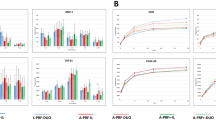Summary
-
1.
Histological observations on sliced human placenta shaked in Krebs-Ringer-solution showed an high plasma polyp formation by the syncytiotrophoblast without any monoiodoacetate or sodiumfluoride poisoining [1].
-
2.
The high plasma polyp formation of placenta slices incubated with gased (96% O2, 4% CO2) Krebs-Ringer-solution and shaked at 37°C decreased rapidly and lasted up to 40 min.
-
3.
Perfusions of the placenta intervillosum with fetal serum added Krebs-Ringer-solution gave results in plasma polyp production up to six times higher than serum free Krebs-Ringer-solution perfusions.
-
4.
Plasma polyp isolation and concentration by one step is discribed applying the inverted centrifugation technique: Plasma polyps migrate centripetally in Krebs-Ringer-solution containing 6% Ficoll (Pharmacia) and were concentrated in the tip of a tube invertedly placed into a swing-out-rotor.
Zusammenfassung
-
1.
Histologische Kontrollen an Humanplacenten, die zwecks Inkubation im Schüttelbad in schmale Streifen aufgeschnitten worden waren, ergaben eine verstärkte Plasmapolypenbildung aus dem Synzytiotrophoblasten auch ohne Vergiftung des Gewebes mit Monojodacetat und NaF [1].
-
2.
Im Schüttelbad bei 37°C, inkubiert mit begaster Krebs-Ringer-Lösung (96% O2, 4% CO2) konnte die starke Polypenbildung rasch abfallend bis zu einer Dauer von 40 min beobachtet werden.
-
3.
Eine Perfusion des intervillösen Raums von menschlichen Placenten mit begaster Krebs-Ringer-Lösung unter Zusatz von frischem Fetalserum erbrachte ebenfalls eine bis zum sechsfachen gesteigerte Plasmapolypenbildung gegenüber der Perfusion mit serumfreier Krebs-Ringer-Lösung.
-
4.
Die Isolierung und Konzentrierung der Plasmapolypen gelingt in einem Arbeitsgang durch Zusatz von Ficoll (Pharmacia) (6%ige Endkonzentration) zur Krebs-Ringer-Lösung und Auffangen der zentripetal wandernden Polypen in einem umgekehrt in den Ausschwingrotor eingeführten Kunststoffröhrchen (umgekehrte Zentrifugation).
Similar content being viewed by others
Literatur
Thorn, W., Kaufmann, P., Müldener, B.: Kohlenhydratumsatz, Energiedefizit und Plasmapolypenbildung in der Placenta nach Vergiftung mit Monojodacetat und NaF. Arch. Gynäk.216, 175–183 (1974)
Kaufmann, P., Thorn, W., Jenke, B.: Die Morphologie der Meerschweinchenplacenta nach Monojodacetat- und Fluorid-Vergiftung. Arch. Gynäk.216, 185–203 (1974)
Thorn, W., Kaufmann, P., Müldener, B., Freese, U.: Einfluß von 2,4-Dinitrophenol, Monojodacetat, Natriumfluorid und Hypoxie auf Plasmapolypenbildung in der Placenta vom Meerschweinchen. Arch. Gynäk.221, 203–210 (1976)
Author information
Authors and Affiliations
Additional information
Mit großzügiger Unterstützung der Deutschen Forschungsgemeinschaft, Thorn 77/29
Rights and permissions
About this article
Cite this article
Mitterer, K.E., Thorn, W. & Ruhrmann, K. In-vitro-Erzeugung von Plasmapolypen in der Humanplacenta und deren Isolierung mit Hilfe der „umgekehrten Zentrifugation“. Res. Exp. Med. 171, 155–162 (1977). https://doi.org/10.1007/BF01851362
Received:
Issue Date:
DOI: https://doi.org/10.1007/BF01851362




